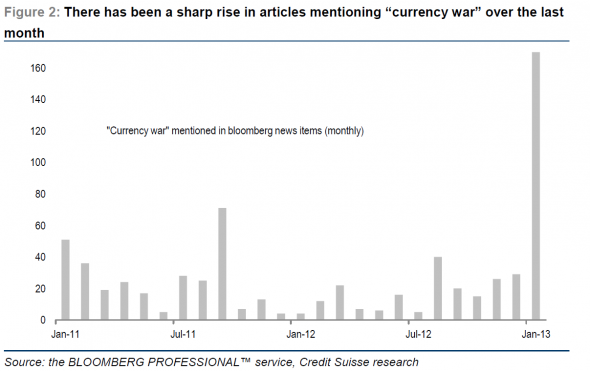You gotta roll with fashion:
I suppose we better spend some more time on the currency wars thing then. *sigh* (Personal FTAV note – why are we still calling it currency wars?)...More Alphaville after the jump. First up Econbrowser:
Over a week ago, Bundesbank President Jen Weidmann warned against the politicization of Japanese monetary policy, as the BoJ was pressured for more expansionary policy. [1] Nouriel Roubini warned that a currency war could be self-defeating as each country’s laxer monetary policy merely resulted in higher commodity prices. [2] I have been wondering exactly how expansionary monetary policy can influence exchange rates in an era of unconventional monetary policy. And even if it can’t affect exchange rates, is that a reason for not pursuing expansionary policy.Figure 1: Nominal value of US dollar (blue, left axis), and Fed funds rate (%) (red, right axis).NBER defined recession dates shaded gray. Source: Fed via FRED, NBER.
Exchange Rate Determination in a New Era
Several months ago, the Economist noted that the usual determinants of (advanced country) exchange rates no longer seemed to affect currency values in the traditional fashion ( Currencies: The weak shall inherit the earth, October 6, 2012):
...Other things being equal, the increase in money supply that a bout of quantitative easing brings should make that currency worth less to other people, and thus lower the exchange rate.As the article points out, the most robust determinant of exchange rates has typically been short term interest differentials (in my view, it’s actually real interest differentials, as in the Dornbusch-Frankel model -- see this survey). Now, it is asserted, it’s long term real bond yields. For more, see this recent WSJ article. (Also, it’s clear that risk is important, as discussed in this IMF working paper)....MORE
Ripple gets a raspberry
Other things, though, are not always or even often equal, as the history of currencies and unconventional monetary policy over the past few years makes clear. In Japan’s case, a drop in the value of the yen in response to the new round of QE would be against the run of play. Japan has conducted QE programmes at various times since 2001 and the yen is much stronger now than when it started.
Nor has QE’s effect on other currencies been what traders might at first have expected. The first American round was in late 2008; at the time the dollar was rising sharply (see chart). The dollar is regarded as the “safe haven” currency; investors flock to it when they are worried about the outlook for the global economy. Fears were at their greatest in late 2008 and early 2009 after the collapse of Lehman Brothers, an investment bank, in September 2008. The dollar then fell again once the worst of the crisis had passed.
...
David Bloom, a currency strategist at HSBC, a bank, draws a clear lesson from all this. “The implications of QE on currency are not uniform and are based on market perceptions rather than some mechanistic link.”
And back to Alphaville:
The euro seems like a sensible place to start. What with it likely being the probable ‘loser’ and all… *double sigh due to concentration on G4 currencies while the fact is it’s the smaller currencies which are unlikely to be able to stand up to the bigger kids*
First, from Credit Suisse:
In our view, the competitive devaluations of developed market currencies is a (not unwelcome) by-product of policymakers’ attempts to lower real bond yields. At the zerobound, policymakers can no longer help their economies by cutting nominal yields – and thus have to resort to lowering real yields by pushing up inflation expectations, leading to a lower real yield (which, in turn, pushes down the currency).There is an important element of contagion in this process: if a country does not expand its balance sheet, then its currency appreciates against those of the countries that do. Currency appreciation continues until the deflationary pressures associated with an overly strong currency become too large and the country is forced to join in the trend of central bank balance sheet expansion. In the case of emerging markets, central banks often engage in unsterilised intervention to keep their currency from appreciating too far (unsterilised because the cost of intervention can be too high for the central bank when US rates are below local GEM rates).With that in mind the current change in relative balance sheet size between the Fed and the ECB is worth noting as it does seem to be consistent with recent euro strength....MUCH MORE
We do not see an end to this process until real bond yields fall to a level that stabilises government debt to GDP and the unemployment rate in developed world.

